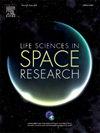微管切断酶KATANIN1参与超重力诱导的拟南芥下胚轴生长各向异性的改变
IF 2.8
3区 生物学
Q2 ASTRONOMY & ASTROPHYSICS
引用次数: 0
摘要
重力对植物各向异性生长的影响机制是空间微重力条件下植物栽培的一个重要问题。本研究旨在研究微管切断酶KATANIN1 (KTN1)在重力诱导的拟南芥下胚轴皮层微管(CMTs)方向改变和生长各向异性中的作用。KTN1突变体(ktn1P393S、ktn1R465Q和ktn1S342F)的下胚轴比野生型(生态型哥伦比亚-0)更短、更厚。300 g时的超重力改变了野生型下胚轴的生长各向异性;超重力抑制伸长,但刺激横向生长。相比之下,超重诱导的生长各向异性的改变在三个突变体的下胚轴中被抑制。野生型在1g条件下横向(0°~ 30°)的CMTs丰富,在超重力条件下纵向(60°~ 90°)的CMTs有增加的趋势。然而,在ktn1突变体的下胚轴中没有观察到超重诱导的重定向。野生型下胚轴中KTN1基因的转录水平在超重处理开始1小时内升高,并迅速下降到与1 g对照相同的水平。这些研究结果表明,cmt的重定向是由KTN1介导的,KTN1通过瞬时表达上调调控,负责改变超重力诱导的拟南芥下胚轴生长各向异性。本文章由计算机程序翻译,如有差异,请以英文原文为准。
Involvement of KATANIN1, a microtubule-severing enzyme, in hypergravity-induced modification of growth anisotropy in Arabidopsis hypocotyls
The mechanism by which gravity affects the growth anisotropy of plant organs is an important issue for the cultivation of plants under microgravity conditions in space. This study aimed to examine the roles of KATANIN1 (KTN1), a microtubule-severing enzyme, in the modification of the direction of cortical microtubules (CMTs) and growth anisotropy in Arabidopsis hypocotyls induced by gravity using hypergravity conditions that can be created on Earth. The KTN1 mutants (ktn1P393S, ktn1R465Q, and ktn1S342F) exhibited shorter and thicker hypocotyls than the wild type (ecotype Columbia-0). Hypergravity at 300 g modified growth anisotropy in wild-type hypocotyls; hypergravity inhibited elongation but stimulated lateral growth. In contrast, hypergravity-induced modification of growth anisotropy was suppressed in hypocotyls of the three mutants. The wild type had an abundance of CMTs in transverse orientation (between 0° and 30°) under 1 g conditions and a tendency toward increased CMTs in longitudinal orientation under hypergravity conditions (between 60° and 90°). However, hypergravity-induced reorientation was not observed in hypocotyls of ktn1 mutants. The transcript level of the KTN1 gene in wild-type hypocotyls increased within 1 h of onset of hypergravity treatment and promptly decreased to the same level as the 1 g control. These findings suggest that the reorientation of CMTs is mediated by KTN1, which is regulated by transient expression upregulation, which is responsible for the modification of growth anisotropy induced by hypergravity in Arabidopsis hypocotyls.
求助全文
通过发布文献求助,成功后即可免费获取论文全文。
去求助
来源期刊

Life Sciences in Space Research
Agricultural and Biological Sciences-Agricultural and Biological Sciences (miscellaneous)
CiteScore
5.30
自引率
8.00%
发文量
69
期刊介绍:
Life Sciences in Space Research publishes high quality original research and review articles in areas previously covered by the Life Sciences section of COSPAR''s other society journal Advances in Space Research.
Life Sciences in Space Research features an editorial team of top scientists in the space radiation field and guarantees a fast turnaround time from submission to editorial decision.
 求助内容:
求助内容: 应助结果提醒方式:
应助结果提醒方式:


